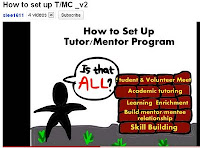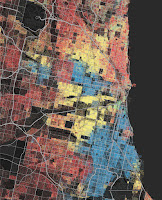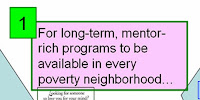If we want great youth serving organizations reaching k-12 youth in all high poverty neighborhoods of Chicago and other places we need to provide traditional training to help staff, volunteers, board members learn how to build effective programs.
However, unless we also educate resource providers, volunteers, media and political leaders to take an active, on-going role that delivers operating resources, talent, ideas and technology to programs in every neighborhood, on an on-going basis, few programs will have the resources needed to put good ideas into practice.
Read on. If you agree, share with people in your own network.
I posted this graphic on
my blog in April 2013. It expresses a lot of ideas. So I thought I’d try to break it down into components. After you review this I encourage volunteers, youth and others to create their own versions, using animation, video, different social media platforms, etc.
Share your versions with me and on social media.
Here is same graphic, but with numbers on different parts. In the paragraphs below I’ll show the meaning.
To get to the goal we want we need to influence both resource providers and program organizers.
First, the goal of this graphic, and the
Tutor/Mentor Institute, LLC is to help high quality, long-term, site-based tutor/mentor programs grow in high poverty neighborhoods.
This section of the Tutor/Mentor web library includes dozens of research articles that show the impact of poverty, indicating the potential benefits of mentor-rich programs.
Second, if we want mentor-rich programs in more high poverty neighborhoods, then we must find ways to increase the flow of needed resources to all programs, and keep this consistent for many years. To do that we need to influence what the donor and resource provider do, not just what programs do.
I’ve followed last week's
National Mentoring Summit and posted comments on Twitter. More than 1,000 people attended virtual the Summit. I shared a few of my Twitter posts in
this article.
The workshops called attention to mentoring as a strategy but even with 1000 participants there are too few paying attention. Two workshops called attention to building relationships as an outcome of organized volunteer-based programs, pointing to
social capital ideas and theory. However, they said, "too few programs actually use social capital terms in describing their strategy and input." In addition, they reported that "too few schools and educators have strategies intended to help youth build needed relationships."
These are “attention gaps” we need to close and we cannot do that without more consistent, and strategic, support from business, public leaders, media and other potential resource providers.
Let’s look at this chart closer:
A tutor/mentor program supports a connection between an adult volunteer with a youth living in an area where indicators show extra adult support and learning activities are needed. NOTE: many mentoring strategies are not primarily focused on youth living in high poverty. However, there is much research showing that for youth living in high poverty the non-school hours offer risk if not filled with positive learning activities and that there are too few resources in most neighborhoods.
The Tutor/Mentor Institute's primary focus is helping mentor rich programs reach youth living in high poverty areas of big cities like Chicago.
There are a wide variety of formal mentoring programs, and many youth are involved in informal mentoring. This 2014 report:
The Mentoring Effect, shows that too few youth are engaged in formal mentoring. This remains true in 2020, and with the remote learning restrictions posted by Covid19, there are even greater gaps in mentoring availability.
This is one graphic from my web site illustrating a need to support youth for many years. On
Pinterest.com you can find more graphics like this, which point to a long-term result, which is when kids have made the journey from first grade through high school, post high school learning, and into jobs with family level wages or better. Our aim is to help youth programs build strategies that support this long-term goal.
View this "
Mentoring Kids to Careers" concept map for a different version of this #birthtowork idea.
This graphic is intended to illustrate the infrastructure needed in every tutor/mentor program. Most people, including youth and volunteers, don’t see the work it takes to recruit and retain youth and volunteers, and find the operating dollars and other resources needed to build an ongoing program. See this graphic at
this link.
This "
tipping point" article talks about building future leaders and donors for mentor-rich programs.
This article uses teams on a football field to visualize the idea that great teams need a wide range of on-going support. So do great youth programs.
I’ve piloted uses of maps since 1994 to illustrate the need for organized tutor/mentor programs in every high poverty neighborhood of Chicago. Without the maps donors and media focus on a few high profile programs, or a few high profile neighborhoods. You don't get a distribution of resources to all of the neighborhoods, or all of the programs, which need consistent support.
The oil well graphic indicates the need for programs to help youth from birth to work. See more maps at
http://mappingforjustice.blogspot.com
Most efforts to support non profits, including tutor/mentor programs, share ideas that help programs improve themselves, and their operations. This
concept map shows a section of the Tutor/Mentor Web library that represents a college of resources that tutor/mentor leaders could draw from to be better at what they do.
However, most smaller programs are so overwhelmed and under financed that they can't draw from this information for on-going learning as much as they need to. This section of the library should be read by business leaders, donors and policy makers. It shows
challenges facing non profits.
As the Iceberg graphic demonstrated, every program has common needs for a wide range of talent. Few have the money to hire all the
talent they need or purchase the best technology and other tools needed to run a high quality business.
This is where we need to grow. Business leaders have tremendous expertise in building chains of stores operating in multiple locations. I wrote about
Polk Bros, showing how advertising and sales promotion were used to draw customers to stores. On Pinterest I show many graphics that illustrate the
role of business and professionals could take to draw needed resources to volunteer-based tutoring and/or mentoring programs all over the city. I created this “
Virtual Corporate office PDF” to illustrate the way volunteer talent in many companies and industries could be mobilized and focused on supporting the growth of tutor/mentor programs throughout big cities like Chicago.
If programs are consistently supported, and are constantly learning from each other, and engaging all of their supporters in efforts to constantly improve the organization’s impact, they should be able to show on their web sites many indicators of their value and impact.
This pdf illustrates some of the things a “shopper” should want to see when looking at a tutor/mentor program’s web site.
Teams of volunteers from business, universities, high schools, etc. could help programs collect and share this information on web sites, and could provide some of the advertising support needed every day to encourage more people to look at these web sites and provide support to help one, or many, programs grow.
As a result of this support there should be many programs with a long-term history and the ability to posts murals like this, showing youth and volunteers who have been part of programs in the past, and who are still connected to those programs today, while helping programs provide services to the next generation of youth.
N
ow, when you look at this graphic, do you understand what it is showing? Can you share this with people in your own network? Take a look at
this blog to see how interns have been creating visualizations and new interpretations of graphics like this. Start a project at your school, or in your church or in your tutor/mentor program, where youth and volunteers create their own interpretations, focusing on your own community and/or school neighborhood if you're not in Chicago.
While Super Bowl advertising is drawing attention to products and services offered by various companies, we need a similar level of outreach to draw attention to ideas like this and to
lists of youth tutor/mentor programs in Chicago and other cities, encouraging volunteers to give time, talent and dollars to build great youth tutoring, mentoring and learning programs in more places.
Since we don't have the advertising dollars to lead such a campaign we depend on the voices of individuals. Can you be one of those voices?





























